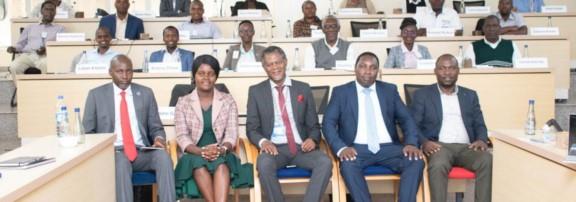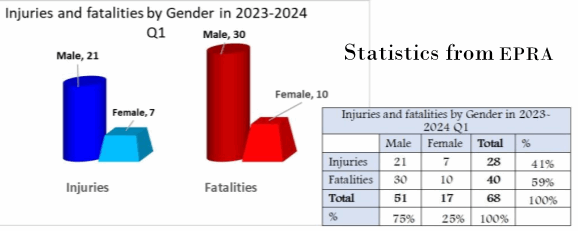
The School of Engineering at Moi university through the Small Grants Scheme by Lloyd’s Register Foundation (LRF) is implementing a project aimed at building a strategic network of stakeholders to co-develop solution approaches for safer and resilient energy infrastructure systems in Kenya. The outcomes of this project will include strengthened level of collaboration and partnership among stakeholders for better management of safety and disaster risks on the energy infrastructure system in Kenya, expanded knowledge of safety and resilience in the energy infrastructure sector, and improved stability of energy supply, which would ultimately contribute to energy security and socio-economic development.
Kenya remains vulnerable to climate-related risks like storms, floods and man-made threats such as violence and crime that compromise the safety and resilience of the energy infrastructure systems. The country experiences frequent incidents on the power and gas supply system, which often disrupt the functioning of critical economic and social services with far reaching consequences on the community, the economy and the environment. According to the energy sector committee report of December 2023 by Energy & Petroleum Regulatory Authority (EPRA), a total of 40 human fatalities and 28 injuries were recorded in the first quarter of 2024, associated with incidences in the power infrastructure systems. That statistic would even be much higher if the fatalities from 280 injuries of gas explosion that occurred in Nairobi on 1st February 2024 are included.
A webinar was organized on 27th March 2024 in Nairobi, Kenya, bringing together key stakeholders from the energy infrastructure sector, academia and the government departments for a candid live conversion. The objective of the webinar was to provide deeper insights on how to integrate safety and resilience agenda in planning, design, operation & maintenance of Kenya’s energy infrastructure systems.

The webinar crystalized the debate on safety and resilience agenda in the energy infrastructure sector with a deep dive into transformative approaches to address safety and resilience challenges in Kenya’s energy infrastructure systems in the wake of climate and man-made risks. The panelists provided informative and thoughtful ideas on how to co-develop solution approaches to address the challenges in the energy infrastructure sector that is continuously expanding in size and complexity.
Panelists

- Eng. Kipkemoi Kibias, the General Manager responsible for Systems Operation and Power Management at Kenya Electricity Transmission Company (KETRACO).
- Eng. Antony Okere, Director in charge of compliance at Engineers Board of Kenya (EBK).
- Eng. Harnes Mukhongo (Moderator), Chief Engineer in charge of Quality Assurance at Kenya Electricity Generating Company (KENGEN).
- Eng. Jonathan K. Mbutu, Rural Electrification and Renewable Energy Corporation (REREC).
- Ms. Faith Koome, Protection Engineer at Kenya Power & Lighting Company
- Eng. Dr. Fenwicks Mosonye, Deputy Director in charge of Energy Efficiency at Energy and Petroleum Regulatory Authority (EPRA).(KPLC).
- Mr. Ignatius Maranga, Association of Energy Professionals, Eastern Africa (AEPEA).
Webinar Talk Points
- Policy and regulatory framework to promote security, safety and stability of energy supply in Kenya (i.e. power supply network, petroleum and gas distribution systems).
- Data-driven decisions on planning, design, operation and maintenance process of Kenya’s energy infrastructure systems for increased safety and resilience to natural and man-made disaster risks.
- Strengthening partnerships, knowledge and information sharing on safety and risk management of energy infrastructure for energy resilience and energy security. The partnerships would serve to create a community of practice to support policy formulation and review, towards improving preparedness and mitigation of disaster risks and increasing resilience of the Kenya’s energy infrastructure system to climate change impacts and other man-made safety risks.
- In-country skills needed to support development of safe and resilient energy infrastructure in Kenya.
Takeaways
- The standards governing the design, construction and maintenance of energy infrastructure are old and require review.
- The Kenya energy infrastructure network is aging. There is need to embrace smart technologies, with capabilities for system adaptation, anticipation, and recovery (self-healing) from disasters and shocks.
- Adaptive protection schemes and mitigation measures should be instituted to manage the challenge of storms and floods that cause severe damage to electricity sub-stations leading to power supply interruptions
- Investment in data management and analysis tools is essential to support decision making process in the energy infrastructure sector.
- The country requires favorable policies to promote safety and resilience actions in the energy infrastructure sector.
- Creating power pools and decentralized electricity generation for sustainability and resilience

One response to “Partnership towards advancing Safety and Resilience of Kenya’s Energy Infrastructure”
This is some dummy copy. You’re not really supposed to read this dummy copy, it is just a place holder for people who need some type to visualize what the actual copy might look like if it were real content.